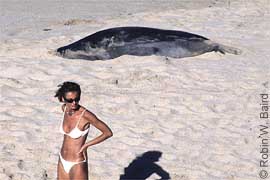 |
|
|
 |
||
Robin W. Baird On October 27, 1999, a monk seal hauled out at the west end of Ho’okipa Beach (20° 56’N, 156° 21’W), on the north shore of east Maui. This site is one of the most popular windsurfing and surfing areas on the island. Although the beach itself is several hundred meters wide, a small sandy area at the west end of the beach (approximately 20 meters wide) is the main site for both surfers and windsurfers to enter the water. The seal reportedly hauled out at 6:30 AM, and was observed by DLNR staff from 8:30 to 9:30 AM (S. Hau, personal communication), with relatively few interactions with humans during that time. Hawaii Wildlife Fund volunteer staff arrived at 10:30 AM, and stayed through to 5 PM. Education efforts were begun by one to two volunteers, and yellow police tape was placed along the beach on two sides of the seal. Because of the large numbers of people using the beach, such "soft-sell" education efforts were largely ineffective. While no counts of people approaching close to the seal were made for the first few or last few hours of the observations, approaches within about 15 meters of the seal were documented for a 2 hour and 50 minute period (between 1:05 PM and 3:55 PM). During this time, a total of 329 people approached within about 15 meters of the hauled out seal (almost 2 people per minute). Virtually all of these interactions were from windsurfers launching and landing from the beach. Because the seal was between 2 and 10 meters from the water’s edge, it was not possible to contact windsurfers as they returned to the beach to inform them of the seal’s presence, or of the relevant regulations and guidelines for minimizing harassment. Many windsurfers, or parts of their windsurfing board or sail, passed within 2-3 meters of the seal. While I was present for only a short period, I observed clear harassment on several occasions, involving the seal lunging towards people walking by. Most disturbing was the presence of a dog within 15 meters of the hauled out seal. The dog was upwind of the seal and did not appear to detect its presence; however, such observations suggest that there is a strong potential for interactions between domestic dogs and monk seals in the main Hawaiian Islands. Risks associated with the presence of dogs not only include disturbance or injury, but also the potential for disease transfer, which could affect the entire population of Hawaiian monk seals. The observations from October 27, 1999 were probably close to the "worst-case" scenario for a monk seal hauled out on Maui (perhaps exceeded by the case of the seal being pummelled by coconuts and whipped by a nylon rope on Maui just over a year earlier, see Jordan 1998). The former monk seal has used the Ho’okipa beach on a number of occasions both since and before the October 1999 observations. The fact that the seal was hauled out on one of the most popular windsurfing beaches, and the resulting large numbers of people, made any sort of educational efforts to control human activities largely ineffective, and clearly official enforcement presence was needed. If Hawaiian monk seals do continue to use the main Hawaiian islands, such high levels of interactions with humans, and with domestic dogs, are likely to increase. A combination of enforcement presence and increased educational efforts will be needed to mitigate such interactions. I would like to thank Allan Ligon and Michele Morris for providing details of their observations from October 27, and for making comments on this review. Jordan D. 1998. The life & times of Q39. The Monachus Guardian 1(2):40-41. Lavigne, D.M. 1999. The Hawaiian monk seal: Management of an endangered species. pp. 246-266. In J.R. Twiss Jr. and R.R. Reeves (eds.). Conservation and Management of Marine Mammals. Smithsonian Institution Press. Washington and London.
MONK SEAL ON THE ISLAND OF MAUI
Biology Department, Dalhousie University, Halifax, Nova Scotia, B3H 4J1 Canada
email: rwbaird@is.dal.ca
The majority of Hawaiian monk seals (Monachus schauinslandi) live in the northwestern Hawaiian Islands, though small numbers are regularly found around the main islands. On the island of Maui, one of the main Hawaiian islands, several individuals have been born in the last few years, and some seals occasionally haul out on beaches heavily used by humans. Management of monk seals in Hawaii is the joint responsibility of the U.S. federal government (through the National Marine Fisheries Service – NMFS) and the State of Hawaii (through the Department of Land and Natural Resources – DLNR) (Lavigne 1999). Volunteer organizations, such as the Hawaii Wildlife Fund, also play a role, particularly in public education efforts when seals do haul out in public areas. Such non-governmental organizations are limited, however, being unable to enforce laws, but they are able to establish on-site education programs informing members of the public about monk seal biology and federal regulations protecting these animals, and encouraging people to voluntarily keep their distance. Volunteers from such non-profit groups will often cordon off an area around a hauled out seal with yellow police tape, and place signs informing individuals of legal restrictions, as well as talking to individuals who are in the area. In Hawaii, a 100 foot (30 m) distance guideline is in place for approaching monk seals and, in theory, the species is protected from disturbance by two U.S. laws, the Marine Mammal Protection Act (MMPA), and the Endangered Species Act (ESA).


Acknowledgements
References
Copyright © 2000 Robin W. Baird, The Monachus Guardian. All Rights Reserved